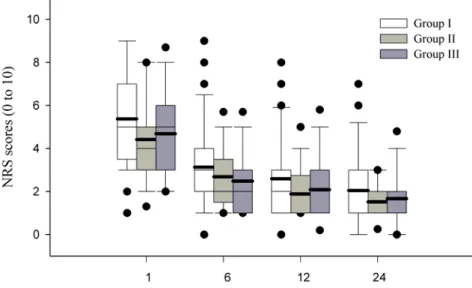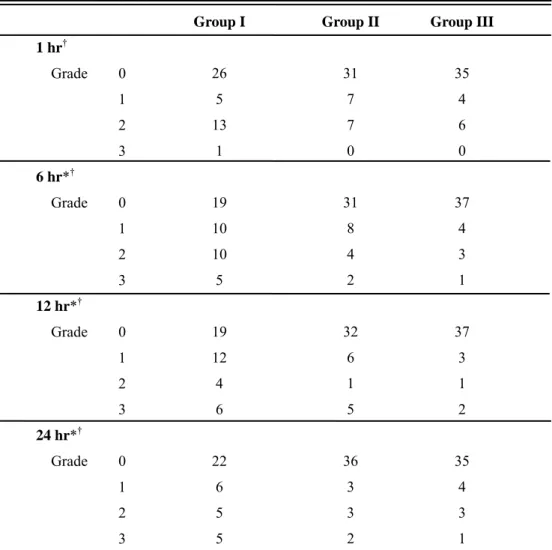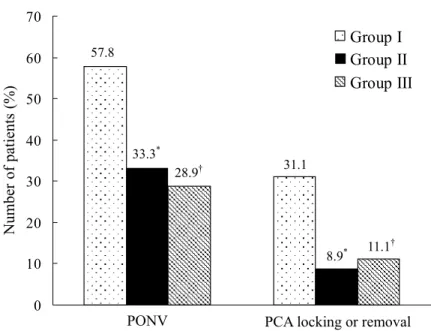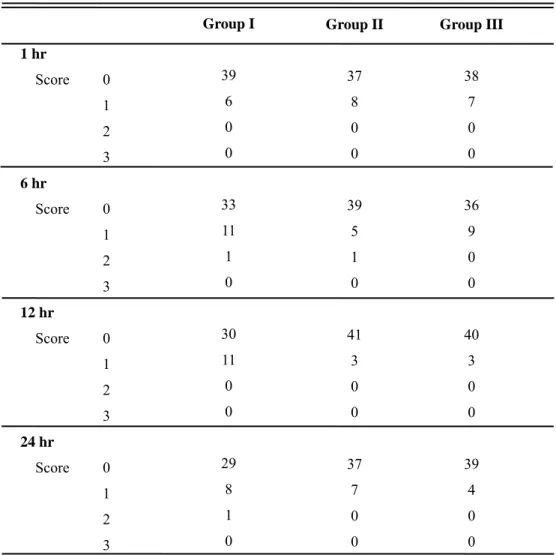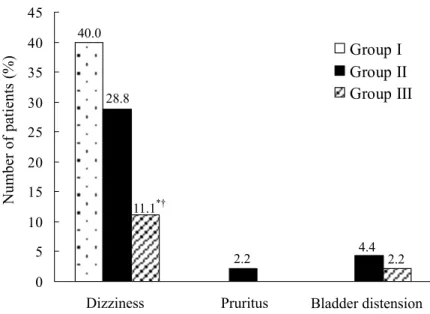Intravenous patient controlled
analgesia in thyroid surgery
: Comparison of three regimens
using fentanyl and ketorolac
So Yeon Kim
Department of Medicine
Intravenous patient controlled
analgesia in thyroid surgery
: Comparison of three regimens
using fentanyl and ketorolac
Directed by Professor Ki Jun Kim
The Master's Thesis
submitted to the Department of Medicine
the Graduate School of Yonsei University
in partial fulfillment of the requirements for the degree
of Master of Medical Science
So Yeon Kim
This certifies that the Master's Thesis
of So Yeon Kim is approved.
---
Thesis Supervisor : Ki Jun Kim
---
Thesis Committee Member#1 : Soon Ho Nam
---
Thesis Committee Member#2 : Bong Soo Cha
The Graduate School
Yonsei University
ACKNOWLEDGEMENTS
My most sincere thanks go to Professor Ki Jun Kim, whose
perspective criticism, kind encouragement, and willing
assistance helped me bring the project to a successful
conclusion. I also wish to express my gratitude to Professor
Soon Ho Nam and Professor Bong Soo Cha who offered
useful suggestions for the content and format of the thesis.
My colleagues especially Eun Mi Kim from the Department
of the Anesthesia and Pain medicine supported me in my
research work. I want to thank them for all their help, support,
interest and valuable hints.
Especially, I would like to give my special thanks to my
husband and my friend Eun Young who enabled me to
complete this work.
<TABLE OF CONTENTS>
ABSTRACT ··· 1
I. INTRODUCTION ··· 3
II. MATERIALS AND METHODS ··· 5
1. MATERIALS ··· 5
2. METHODS ··· 5
III. RESULTS ··· 8
IV. DISCUSSION ··· 14
V. CONCLUSION ··· 18
REFERENCES ··· 19
ABSTRACT(IN KOREAN) ··· 25
LIST OF FIGURES
Figure 1. Numerical rating scale (NRS) for pain during
postoperative period ··· 9
Figure 2. Incidence of postoperative nausea and vomiting
(PONV) and locking or removal of PCA during
postoperative 24hrs··· 11
Figure 3. Incidence of other side effects during postopera-
LIST OF TABLES
Table 1. Patients characteristics ··· 8
Table 2. Postoperative nausea grades in three groups ··· 10
<ABSTRACT>
Intravenous patient controlled analgesia in thyroid surgery
: Comparison of three regimens using fentanyl and ketorolac
So Yeon Kim
Department of Medicine
The Graduate School, Yonsei University
(Directed by Professor Ki Jun Kim)
After thyroidectomy, patients have moderate pain that need opioid
treatment and they usually have nausea or vomiting. Intravenous patient
controlled analgesia (i.v. PCA) with opioid can control postoperative pain
well, but it can cause nausea or vomiting. But NSAIDs, through a
synergistic action with opioids, can reduce these systemic side effects.
The aim of this study was to compare the analgesic efficacy and side
effects of three PCA regimens using fentanyl and ketorolac and to
determine the appropriate dosage of fentanyl and ketorolac in thyroid
surgery. One hundred and thirty-five patients undergoing elective
(n=45), fentanyl 15 µg/kg + ondansetron 12 mg, Group II (n=45),
fentanyl 12.5 µg/kg + ketorolac 1.5 mg/kg + ondansetron 12 mg, Group
III (n=45), fentanyl 10 µg/kg + ketorolac 3 mg/kg + ondansetron 12 mg.
Drugs of each group were mixed with normal saline in a total volume of
100 ml. Basal infusion rate was 2 ml/hr and the lockout interval was 15
mins with the bolus dose of 0.5 ml. After the specimen was removed, i.v.
PCA was connected. Pain scores, nausea and vomiting and other side
effects were assessed at postoperative 1, 6, 12 and 24 hrs respectively.
Pain scores were similar among three groups. But postoperative nausea
and vomiting (PONV) was significantly lower in groups II and III (p <
0.05) compared with group I. Postoperative dizziness was significantly
lower in group III compared with groups I and II (p < 0.05). We conclude
that i.v. PCA with fentanyl 10 µg/kg, ketorolac 3 mg/kg and ondansetron
12 mg causes minimal side effects such as PONV and dizziness in
thyroid surgery.
---
Intravenous patient controlled analgesia in thyroid surgery
: Comparison of three regimens using fentanyl and ketorolac
So Yeon Kim
Department of Medicine
The Graduate School, Yonsei University
(Directed by Professor Ki Jun Kim)
I. INTRODUCTION
One of the most common methods for providing postoperative analgesia is via patient-controlled analgesia (PCA). It has been used since the late 1960s.1
Nowadays it is used not only in major surgery but also in minor surgery for post operative pain control. PCA reduces analgesics requirements and it increases patient satisfaction and progress after surgey.2,3
Although thyroid surgery is a short-stay procedure, pain after thyroid surgery is expected to be moderate.4,5 It has been reported that the mean postoperative
pain score was 6.9 on a visual analog scale (VAS) from 1 to 10 and 90% of the patients required morphine during the first postoperative day.6 Other studies have reported the need for opioid analgesia at least in the early postoperative
period.7-9 Besides, thyroid surgery carries a major risk of nausea and vomiting
because it is a cervicofacial surgery performed mainly in women.10,11 Therefore,
after thyroid surgery, it is important to control pain and reduce nausea and vomiting.
Opioids and nonsteroidal anti-inflammatory drugs (NSAIDs) are used in postoperative pain control. Opioids can increase postoperative nausea and vomiting and other side effects, such as sedation, dizziness, urinary retention and pruritus.12 But NSAIDs, through synergistic action with opioids,13-16 can reduce these systemic side effects.17,18 In thyroid surgery, use of NSAIDs like ketoprofen reduced the pain score as well as morphine requirements and related side effects such as nausea and vomiting.19 And the addition of ketoprofen
improved analgesia in patients who received intraoperative fentnyl.20
Many studies reported about postoperative pain control ways, such as local anesthetic wound infiltration,6,21 bilateral superficial cervical plexus block7,22,23
and greater occipital nerve block24 in thyroid surgery. But the efficacy of
intravenous PCA (i.v. PCA) in thyroid surgery has not yet been assessed. The aim of this study was to compare the analgesic efficacy and side effects of three PCA regimens using fentanyl and ketorolac and to determine the appropriate dosage of fentanyl and ketorolac in thyroid surgery.
II. MATERIALS AND METHODS 1. MATERIALS
This study was approved by Yonsei University, Medical School Review Board for human investigation and written informed consent was obtained from all patients (including the preliminary study). One hundred thirty-five patients who were ASA physical status I-II, female patients aged 20-60 yr and scheduled for elective thyroid surgery due to thyroid cancer were enrolled in this study. Thyroid surgery was performed by the same surgeon with a similar surgical technique and surgical drains. All patients were euthyroid state at the time of surgery. Patients were excluded if they had renal failure, bleeding tendency, a known allergy or any contraindication to the use of NSAIDs.
2. METHODS
We considered PONV as the primary outcome, and assumed the incidence of PONV to be approximately 50% in Group I (many studies had shown the incidence of opioid-induced emesis in the post-surgical setting to range between 10% and 50%25-27) and 25% in group II, III (a reduction of nausea and vomiting from 50% to 25% was considered as clinical importance11,28). Thus, the sample size of 45 patients in each group provided 80% power at the 95% level of significance.
Using a random number sequence, patients (n=135) were randomly divided into three PCA groups : Group I (n=45), fentanyl citrate (Fentanyl®, Ha Na
Pharm, Seoul, Korea) 15 µg/kg + ondansetron (Onseran®, Yuhan, Seoul, Korea) 12 mg, Group II (n=45), fentanyl 12.5 µg/kg + ketorolac tromethamine (Tarasyn®, Roche Korea, Seoul, Korea) 1.5 mg/kg + ondansetron 12mg, Group III (n=45), fentanyl 10 µg/kg + ketorolac 3 mg/kg + ondansetron 12mg. Drugs of each group were mixed with normal saline in a total volume of 100 ml. The regimen was based on the study that 60 mg of ketorolac and 100 mg of fentanyl was equianalgesic29 and on Food and Drug Administration (FDA) recommendation that total daily dose of injectable ketorolac is 120 mg. Basal infusion rate was 2 ml/hr and the lockout interval was 15 mins with the bolus dose of 0.5 ml.
Patients were premedicated with midazolam 0.04 mg/kg i.m. 30 minutes before surgery. General anesthesia was induced with remifentanil 1 µg/kg and propofol 1-2 mg/kg. Orotracheal intubation was done after administration of rocuronium bromide 0.8 mg/kg. Anesthesia was maintained with remifentanil 0.05-0.15 µg/kg/min and 1.5-2% end tidal sevoflurane in 50% O2/air. After the
specimen was removed, i.v. PCA (Accufuser Plus®, P2015M, Woo Young Medical, Korea) was connected. At the time of skin suture, ondansetron 4 mg was injected. No other analgesics and dexamethasone were given during operation.
The assessment of pain and side effects such as nausea and vomiting, sedation, dizziness, urinary retention and pruritus were made at postoperative 1, 6, 12 and
were instructed preoperatively to express their pain on the 0-10 NRS, where 0 meant no pain at all and 10 represented the worst pain imaginable. Nausea and vomiting were graded on a four point scale as 0 = no nausea, 1 = mild nausea, 2 = severe nausea which needs anti-emetics, 3 = retching and/or vomiting. Grades 3 and 4 were grouped together as postoperative nausea and vomiting (PONV). We recorded sedation score on a four point scale as 0 = awake, 1 = mild, 2 = sleepy but awakable, 3 = very sleepy. When patients wanted more pain control, further injection of fentanyl 50 µg or ketorolac 30 mg were allowed. The patients of PONV group (grade 2 and 3) were given antiemetics, metoclopramide 10 mg or ondansetron 4 mg. When patients didn't want PCA because of side effects, PCA was locked for a while or removed.
Statistical analysis was performed using SPSS 12.0 (SPSS Inc., Chicago, IL, USA). Parametric data (age, weight, BMI, duration of operation, pain scores) were analyzed using one-way ANOVA. The nausea and vomiting were compared using Kruskal-Wallis test. If the test proved significant, a Mann-Whitney U test with Bonferroni correction was used to evaluate differences between groups. Discrete variables (history of motion sickness, PONV, PCA removal, other side effects) were analyzed with Chi-square test. All values were presented as means ± standard deviation (SD) or percentage. A p value < 0.05 was considered as statistically significant.
III. RESULTS
A total of 135 patients (45 in each group) completed the protocol. There were no differences in patients characteristics among three groups (Table 1).
Table 1. Patients characteristics
Values are mean ± SD or number of patients (percentage).
Group I : fentanyl 15 µg/kg + ondansetron 12 mg; Group II : fentanyl 12.5 µg/kg + ketorolac 1.5 mg/kg + ondansetron 12mg; Group III : fentanyl 10 µg/kg + ketorolac 3 mg/kg + ondansetron 12mg. No significant differences among three groups.
BMI = body mass index.
Postoperative pain scores were similar among three groups (Figure 1). Nausea grades were significantly lower in Group III compared with Group I at postoperative 1 hr (p < 0.05). And it were significantly lower in Group II and III compared with Group I at postoperative 6, 12 and 24 hrs (p < 0.05). But nausea grades were not different between Group II and III (Table 2).
Age (yrs) Weight (kg) BMI (kg/m2)
History of motion sickness Duration of operation (mins)
Group I (n = 45) 47.0 ± 7.0 58.9 ± 7.7 23.9 ± 2.9 7 (15.6%) 126 ± 33 Group II (n = 45) 47.5 ± 8.1 60.2 ± 7.3 24.1 ± 2.7 7 (15.6%) 118 ± 20 Group III (n = 45) 50.3 ± 7.5 61.5 ± 8.4 25.2 ± 3.9 8 (17.8%) 121 ± 20
Figure 1. Numerical rating scale (NRS) for pain during postoperative period. Box plot with median (solid line), mean (bold line), 25th-75th percentiles (box), and 10th-90th percentiles (whiskers). Outliers are indicated by the solid circles. Group I was received i.v. PCA with fentanyl 15 µg/kg and ondansetron 12 mg. Group II was received i.v. PCA with fentanyl 12.5 µg/kg, ketorolac 1.5 mg/kg and ondansetron 12mg. Group III was received i.v. PCA with fentanyl 10 µg/kg, ketorolac 3 mg/kg and ondansetron 12mg. No significant differences among three groups.
Table 2. Postoperative nausea grades in three groups
Group I : fentanyl 15 µg/kg + ondansetron 12 mg; Group II : fentanyl 12.5 µg/kg + ketorolac 1.5 mg/kg + ondansetron 12mg; Group III : fentanyl 10 µg/kg + ketorolac 3 mg/kg + ondansetron 12mg.
Grade was : 0 = no nausea, 1 = mild nausea, 2 = severe nausea which needs anti-emetics, 3 = retching and/or vomiting.
*Significant difference at p < 0.05 between Group I and II. †Significant difference at p < 0.05 between Group I and III.
After locking or removal of PCA, we didn't check nausea grades of patients. So total number of patients was different on times.
Group I 26 5 13 1 19 10 10 5 19 12 4 6 22 6 5 5 Group II 31 7 7 0 31 8 4 2 32 6 1 5 36 3 3 2 Group III 35 4 6 0 37 4 3 1 37 3 1 2 35 4 3 1 1 hr† Grade 0 1 2 3 6 hr*† Grade 0 1 2 3 12 hr*† Grade 0 1 2 3 24 hr*† Grade 0 1 2 3
Incidence of PONV was lower in Group II (33.3%) and III (28.9%) compared with Group I (57.8%) during postoperative 24 hrs (p < 0.05). But it was not different between Group II and III. The proportion of patients who wanted locking or removal of PCA was higher in Group I (31.1%) compared with Group II (8.9%) and III (11.1%) (p < 0.05). But it was not different between Group II and III (Figure 2).
Figure 2. Incidence of postoperative nausea and vomiting (PONV) and locking or removal of PCA during postoperative 24hrs. Nausea grade 2 and 3 were grouped together as PONV. Group I was received i.v. PCA with fentanyl 15 µg/kg and ondansetron 12 mg. Group II was received i.v. PCA with fentanyl 12.5 µg/kg, ketorolac 1.5 mg/kg and ondansetron 12mg. Group III was received i.v. PCA with fentanyl 10 µg/kg, ketorolac 3 mg/kg and ondansetron 12mg. *Significant difference at p < 0.05 between Group I and II in PONV and PCA locking or removal. †Significant difference at p < 0.05 between Group I and III in PONV and PCA locking or removal.
0 10 20 30 40 50 60 70 Nu mber of patients (%) Group I Group II Group III
PONV PCA locking or removal
28.9† 31.1
11.1†
8.9*
57.8
No difference was noticed with regard to sedation (Table 3). Sedation score 3 was never seen in all groups. And sedation score 2 was never seen in Group III.
Table 3. Postoperative sedation scores in three groups
Group I : fentanyl 15 µg/kg + ondansetron 12 mg; Group II : fentanyl 12.5 µg/kg + ketorolac 1.5 mg/kg + ondansetron 12mg; Group III : fentanyl 10 µg/kg + ketorolac 3 mg/kg + ondansetron 12mg.
Scoring was : 0 = awake, 1 = mild, 2 = sleepy but awakable, 3 = very sleepy. No significant differences among three groups.
After locking or removal of PCA, we didn't check sedation score of patients. So total 1 hr Score 0 1 2 3 6 hr Score 0 1 2 3 12 hr Score 0 1 2 3 24 hr Score 0 1 2 3 Group I 39 6 0 0 33 11 1 0 30 11 0 0 29 8 1 0 Group II 37 8 0 0 39 5 1 0 41 3 0 0 37 7 0 0 Group III 38 7 0 0 36 9 0 0 40 3 0 0 39 4 0 0
Incidence of other side effects is shown in Figure 3. Dizziness was significantly lower in Group III (11.1%) compared with Group I (40.0%) and II (28.8%) (p < 0.05). But Group I and II was not different in dizziness. There were no differences in pruritus and bladder distension between three groups.
Figure 3. Incidence of other side effects during postoperative 24hrs. Group I was received i.v. PCA with fentanyl 15 µg/kg and ondansetron 12 mg. Group II was received i.v. PCA with fentanyl 12.5 µg/kg, ketorolac 1.5 mg/kg and ondansetron 12mg. Group III was received i.v. PCA with fentanyl 10 µg/kg, ketorolac 3 mg/kg and ondansetron 12mg. Significant difference at p < 0.05 between Group I and III in dizziness. †Significant difference at p < 0.05 between Group II and III in dizziness.
0 5 10 15 20 25 30 35 40 45 Nu mber o f patients ( % ) Group I Group II Group III
Dizziness Pruritus Bladder distension
28.8
11.1*†
2.2 4.4 2.2 40.0
IV. DISCUSSION
The benefits of i.v. PCA compared with intermittent i.m. injection of opioids have been best summarized in two published systemic reviews.30,31 Both of
these evidence-based reviews concluded that i.v. PCA offers better analgesic efficacy as well as superior patient satisfaction. With intermittent bolus administration, there are frequent periods with the concentration more than and less than the target analgesic concentration. In contrast, PCA results in the opioid concentration being in the target range for a large percentage of time.32
After thyroid surgery, most patients require effective postoperative analgesia. The causes of pain are a cervicotomy itself, an operative cervical hyperextension that causes postoperative muscular cervicalgia33 and an orotracheal intubation that causes postoperative irritation and laryngeal discomfort projecting into the operated region.34 Postoperative discomfort can also be increased by the cervical drains, which are kept in place for 24 hours.10 In our study, patients complained of pain at the incision site, sore throat, posterior neck pain and headache. Pain at the incision site and sore throat were the most common complaints. Also the most common headache was an occipital headache. Gozal et al.6 and Bagul et al.21 reported that bupivacaine
wound infiltration reduced postoperative pain and opioid demand in thyroid surgery. Han et al.24 reported that greater occipital nerve block with bupivacaine
reduced occipital headache and posterior neck pain after thyroid surgery. These studies focused on the efficacy of regional techniques.
However,
themechanism of pain after thyroidectomy is complex, so we need other general pain control methods. Because i.v. PCA controls pain in a systemic manner, it would control complex pains in thyroid surgery. As a preliminary study, we estimated the pain of 30 patients who did not receive i.v. PCA after thyroidectomy. The mean postoperative numerical rating scale (NRS, 0-10) of these patients was 6.7 at 1 hr, 4.8 at 6 hrs, 3.9 at 12 hrs and 2.6 at 24 hrs. It was significantly higher than that of the PCA group of our study (p < 0.05).
Postoperative nausea and vomiting (PONV) is the most common and most bothersome side effect of i.v. PCA. Certain surgical procedure, drugs used during anesthesia, pain, anxiety and dehydration are all associated with an increased incidence of PONV.35 Therefore thyroid surgery and opioid-based i.v.
PCA can increase the incidence of PONV. Sonner et al.11 reported the incidence
of PONV was 54% in thyroid surgery. In our study, the incidence of PONV was 33.3% in Group II and 28.9% in Group III. So i.v. PCA with opioid and ketorolac did not increase the incidence of PONV.
Morphine remains the "gold standard" for i.v. PCA, as the most studied and most commonly used i.v. PCA drug in the United States.36But morphine has an
active metabolite−morphine-6-glucuronide(M6G)−that also induces analgesia, sedation, and respiratory depression. Whereas morphine is eliminated mainly by glucuronidation, its active metabolite relies predominantly on renal excretion for elimination. Prolonged and profound delayed onset respiratory depression has been reported in patients with renal failure receiving parenteral morphine.37
Fentanyl is a good alternative for morphine-intolerant patients or those with altered renal function because it does not rely on renal excretion for elimination. Because of its lipophilicity, fentanyl has a quicker onset than morphine, so it makes fentanyl better suited for i.v. PCA. Fentanyl has been used successfully for i.v. PCA.38,39 Therefore, fentanyl would be more suitable than morphine in a
short duration of surgery like a thyroidectomy.
NSAIDs such as ketorolac inhibit the synthesis of prostaglandins both in the spinal cord and at the periphery, thus diminishing the hyperalgesic state after a surgical trauma.40 The analgesic synergy of NSAID-opioid combination was first demonstrated by McQuay et al..14 And the efficiency of NSAIDs in thyroid surgery also has been assessed in several studies.19,20 In our study, the pain
scores of the NSAIDs added groups (Group II and III) were similar to that of the fentanyl only group (Group I) (Figure 1). But PONV was significantly lower in the NSAIDs added groups (Group II and III) (Figure 2). Therefore, the addition of NSAIDs in an opioid-based i.v. PCA can reduce PONV in thyroid surgery.
Twenty three patients from among 135 patients wanted locking or removal of the PCA (Figure 2). The reasons were severe nausea or vomiting in 21 patients and dizziness in 2 patients. Dizziness was significantly lower in Group III compared with Group I and II (Figure 3). Therefore more NSAIDs added group (Group III) had a lower incidence of both PONV and dizziness.
rare, with an incidence of 0.5% to 1.5%.41-43 NSAIDs administration may
theoretically increase the postoperative bleeding risk44 and thus the risk of
compressive cervical hematoma. This is linked to the modifications of the coagulation system caused by treatment even of a very short duration. Although a retrospective study has shown an increase in perioperative bleeding and wall hematomas in patients treated for long periods with NSAIDs,45 prospective
studies have not shown an increase in the risk of postoperative hemorrhage with treatments lasting less than five days and started during or after the operation.18,46,47 In our study, no cases of hematoma occurred.
The 5-HT3 receptor antagonists are highly specific and selective for nausea
and vomiting. Members of this group exert their effects by binding to the 5-HT3
receptor in the chemoreceptor trigger zone and at vagal afferents in the gastrointestinal tract. Ondansetron was the first member of this group to be marketed in the USA and was the most widely studied. It is most effective when given at the end of surgery.48,49 The recommended dose for prophylaxis is 4 to 8
mg i.v. in adults.50 Therefore we mixed ondansetron 12 mg in the i.v. PCA and
V. CONCLUSION
Intravenous PCA with fentanyl 10 µg/kg, ketorolac 3 mg/kg and
ondansetron 12 mg causes minimal side effects such as PONV and
REFERENCES
1. Sechzer P. Objective measurement of pain. Anesthesiology 1968;29:209-10. 2. Egbert AM, Parks LH, Short LM, Burnett ML. Randomized trial of
postoperative patient-controlled analgesia vs intramuscular narcotics in frail elderly men. Arch Intern Med 1990;150:1897-903.
3. Hopf HW, Weitz S. Postoperative pain management. Arch Surg
1994;129:128-32.
4. Defechereux T, Degauque C, Fumal I, Faymonville ME, Joris J, Hamoir E, et
al. Hypnosedation, a new method of anesthesia for cervical endocrine surgery. Prospective randomized study. Ann Chir 2000;125:539-46.
5. Defechereux T, Meurisse M, Hamoir E, Gollogly L, Joris J, Faymonville ME.
Hypnoanesthesia for endocrine cervical surgery: a statement of practice. J Altern Complement Med 1999;5:509-20.
6. Gozal Y, Shapira SC, Gozal D, Magora F. Bupivacaine wound infiltration in
thyroid surgery reduces postoperative pain and opioid demand. Acta Anaesthesiol Scand 1994;38:813-5.
7. Aunac S, Carlier M, Singelyn F, De Kock M. The analgesic efficacy of
bilateral combined superficial and deep cervical plexus block administered before thyroid surgery under general anesthesia. Anesth Analg 2002;95:746-50.
8. Karamanlioglu B, Arar C, Alagol A, Colak A, Gemlik I, Sut N. Preoperative
oral celecoxib versus preoperative oral rofecoxib for pain relief after thyroid surgery. Eur J Anaesthesiol 2003;20:490-5.
9. Vach B, Kurzova A, Malek J, Fanta J, Pachl J. Infiltration of local anesthetics
Chir 2002;81:519-22.
10. Daou R. Thyroidectomy without drainage. Chirurgie 1997;122:408-10. 11. Sonner JM, Hynson JM, Clark O, Katz JA. Nausea and vomiting following
thyroid and parathyroid surgery. J Clin Anesth 1997;9:398-402.
12. Rushton AR, Sneyd JR. Opioid analgesics. Br J Hosp Med 1997;57:105-6. 13. Dahl JB, Kehlet H. Non-steroidal anti-inflammatory drugs: rationale for use
in severe postoperative pain. Br J Anaesth 1991;66:703-12.
14. McQuay HJ, Carroll D, Watts PG, Juniper RP, Moore RA. Codeine 20 mg
increases pain relief from ibuprofen 400 mg after third molar surgery. A repeat-dosing comparison of ibuprofen and an ibuprofen-codeine combination. Pain 1989;37:7-13.
15. Sunshine A, Roure C, Olson N, Laska EM, Zorrilla C, Rivera J. Analgesic
efficacy of two ibuprofen-codeine combinations for the treatment of postepisiotomy and postoperative pain. Clin Pharmacol Ther 1987;42:374-80.
16. Tauzin-Fin P, Delort-Laval S, Guenard Y, Krol-Houdek MC, Muscagorry
JM, Maurette P. Comparative study of buprenorphine and its combination to ketoprofen or propacetamol for postoperative analgesia in urologic surgery. Ann Fr Anesth Reanim 1996;15:41-6.
17. Beaver WT. Aspirin and acetaminophen as constituents of analgesic
combinations. Arch Intern Med 1981;141:293-300.
18. Kokki H, Nikanne E, Tuovinen K. I.v. intraoperative ketoprofen in small
children during adenoidectomy: a dose-finding study. Br J Anaesth 1998;81:870-4.
Intravenous ketoprofen in thyroid and parathyroid surgery. Anesth Analg 2001;92:1052-7.
20. Motamed C, Merle JC, Combes X, Yakhou L, Vodinh J, Duvaldestin P. The
effect of fentanyl and remifentanil, with or without ketoprofen, on pain after thyroid surgery: a randomized-controlled trial. Eur J Anaesthesiol 2006;23:665-9.
21. Bagul A, Taha R, Metcalfe MS, Brook NR, Nicholson ML. Pre-incision
infiltration of local anesthetic reduces postoperative pain with no effects on bruising and wound cosmesis after thyroid surgery. Thyroid 2005;15:1245-8.
22. Eti Z, Irmak P, Gulluoglu BM, Manukyan MN, Gogus FY. Does bilateral
superficial cervical plexus block decrease analgesic requirement after thyroid surgery? Anesth Analg 2006;102:1174-6.
23. Herbland A, Cantini O, Reynier P, Valat P, Jougon J, Arimone Y, et al. The
bilateral superficial cervical plexus block with 0.75% ropivacaine administered before or after surgery does not prevent postoperative pain after total thyroidectomy. Reg Anesth Pain Med 2006;31:34-9.
24. Han DW, Koo BN, Chung WY, Park CS, Kim SY, Palmer PP, et al.
Preoperative greater occipital nerve block in total thyroidectomy patients can reduce postoperative occipital headache and posterior neck pain. Thyroid 2006;16:599-603.
25. Harmer M, Slattery PJ, Rosen M, Vickers MD. Intramuscular on demand
analgesia: double blind controlled trial of pethidine, buprenorphine, morphine, and meptazinol. Br Med J 1983;286:680-2.
sufentanil, morphine and sufentanil-morphine combination after caesarean section. Br J Anaesth 1992;69:9-12.
27. Robinson SL, Fell D. Nausea and vomiting with use of a patient-controlled
analgesia system. Anaesthesia 1991;46:580-2.
28. Jokela R, Koivuranta M, Kangas-Saarela T, Purhonen S, Alahuhta S. Oral
ondansetron, tropisetron or metoclopramide to prevent postoperative nausea and vomiting: a comparison in high-risk patients undergoing thyroid or parathyroid surgery. Acta Anaesthesiol Scand 2002;46:519-24.
29. Lippmann M, Ginsburg R. Ketorolac versus dezocine versus fentanyl: what
is the true equianalgesic potency ratio? Anesth Analg 1993;76:1170-1.
30. Ballantyne JC, Carr DB, Chalmers TC, Dear KB, Angelillo IF, Mosteller F.
Postoperative patient-controlled analgesia: meta-analyses of initial randomized control trials. J Clin Anesth 1993;5:182-93.
31. Walder B, Schafer M, Henzi I, Tramer MR. Efficacy and safety of
patient-controlled opioid analgesia for acute postoperative pain. A quantitative systematic review. Acta Anaesthesiol Scand 2001;45:795-804.
32. Ferrante F, Ostheimer G, Covino B. Patient-controlled analgesia: a
historical perspective. Boston: Blackwell Scientific Publications; 1990.
33. Bliss RD, Gauger PG, Delbridge LW. Surgeon's approach to the thyroid
gland: surgical anatomy and the importance of technique. World J Surg 2000;24:891-7.
34. McHardy FE, Chung F. Postoperative sore throat: cause, prevention and
treatment. Anaesthesia 1999;54:444-53.
2002;287:1233-6.
36. Grass JA. Patient-controlled analgesia. Anesth Analg 2005;101:S44-61. 37. Osborne RJ, Joel SP, Slevin ML. Morphine intoxication in renal failure: the
role of morphine-6-glucuronide. Br Med J 1986;292:1548-9.
38. Howell PR, Gambling DR, Pavy T, McMorland G, Douglas MJ.
Patient-controlled analgesia following caesarean section under general anaesthesia: a comparison of fentanyl with morphine. Can J Anaesth 1995;42:41-5.
39. Lehmann KA, Heinrich C, van Heiss R. Balanced anesthesia and
patient-controlled postoperative analgesia with fentanyl: minimum effective concentrations, accumulation and acute tolerance. Acta Anaesthesiol Belg 1988;39:11-23.
40. McCormack K. Non-steroidal anti-inflammatory drugs and spinal
nociceptive processing. Pain 1994;59:9-43.
41. Bergamaschi R, Becouarn G, Ronceray J, Arnaud JP. Morbidity of thyroid
surgery. Am J Surg 1998;176:71-5.
42. Defechereux T, Hamoir E, Nguyen Dang D, Meurisse M. Drainage in
thyroid surgery. Is it always a must?. Ann Chir 1997;51:647-52.
43. Shaha A, Jaffe BM. Complications of thyroid surgery performed by
residents. Surgery 1988;104:1109-14.
44. Niemi TT, Taxell C, Rosenberg PH. Comparison of the effect of
intravenous ketoprofen, ketorolac and diclofenac on platelet function in volunteers. Acta Anaesthesiol Scand 1997;41:1353-8.
stopped before elective surgery? Arch Intern Med 1991;151:1963-6.
46. Hommeril JL, Bernard JM, Gouin F, Pinaud M. Ketoprofen for pain after
hip and knee arthroplasty. Br J Anaesth 1994;72:383-7.
47. Rorarius MG, Baer GA, Siirtola M, Lahti T, Laippala P. Effect of
intravenous diclofenac or indomethacin on the emergence from anaesthesia for tonsillectomy. Acta Anaesthesiol Scand 1993;37:616-21.
48. Sun R, Klein KW, White PF. The effect of timing of ondansetron
administration in outpatients undergoing otolaryngologic surgery. Anesth Analg 1997;84:331-6.
49. Tang J, Wang B, White PF, Watcha MF, Qi J, Wender RH. The effect of
timing of ondansetron administration on its efficacy, cost-effectiveness, and cost-benefit as a prophylactic antiemetic in the ambulatory setting. Anesth Analg 1998;86:274-82.
50. Tramer MR, Reynolds DJ, Moore RA, McQuay HJ. Efficacy, dose-response,
and safety of ondansetron in prevention of postoperative nausea and vomiting: a quantitative systematic review of randomized placebo-controlled trials. Anesthesiology 1997;87:1277-89.

